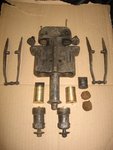Italian drawn cutaway of a Lancaster Mk 1 showing the cable cutting mechanism. Appears that there were eight cutters spread out along the leading edge.
-How many bombers of WWII utilised similar devices?
-As bombing tactics changed, did the need cease to exist?
-With this particular method, what powered the cold chisels(?) cutting action, and what happened if the cable was not severed with the first impact?
That'll do, thanks!

-How many bombers of WWII utilised similar devices?
-As bombing tactics changed, did the need cease to exist?
-With this particular method, what powered the cold chisels(?) cutting action, and what happened if the cable was not severed with the first impact?
That'll do, thanks!








